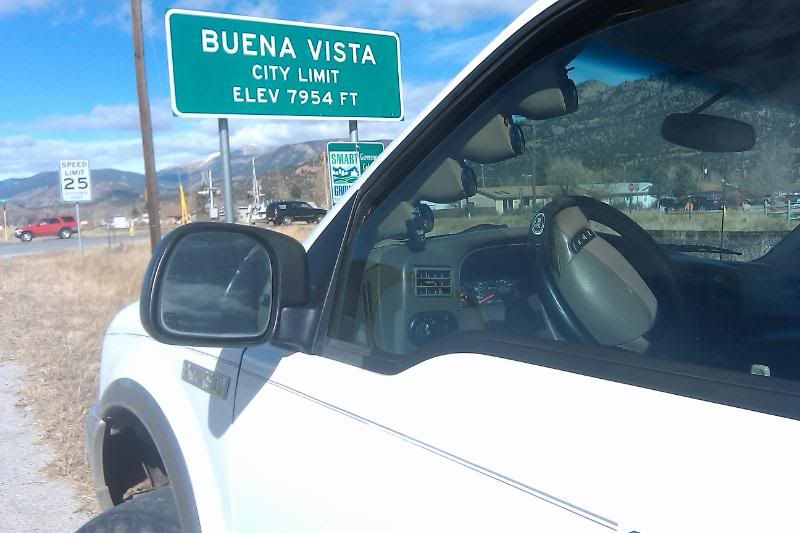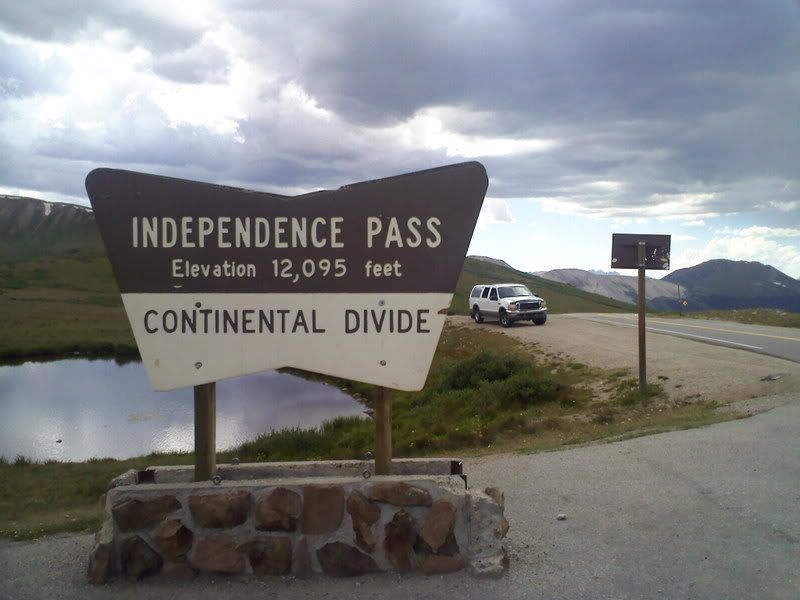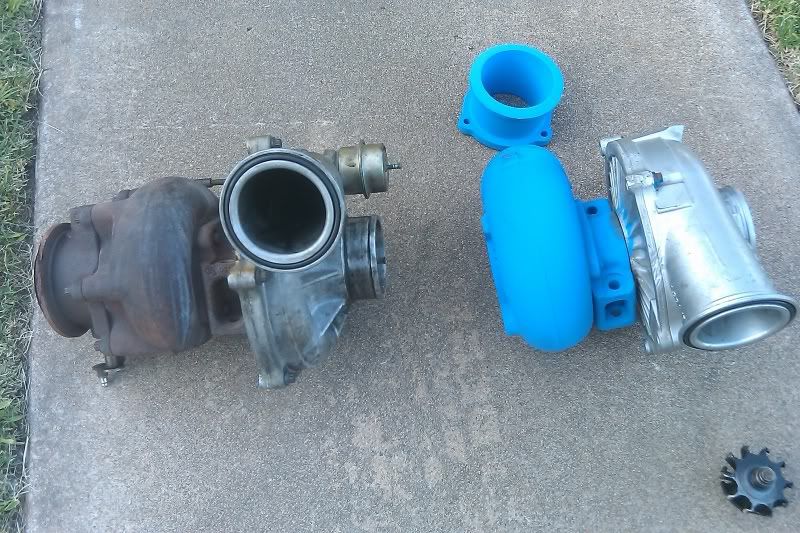van turbo ww2
#16
#17
#18
It's not one size fits all. I really enjoy towing with the Stage 1 sticks & Van turbo in our F-250 like SkySkiJason does. It has worked great for 8+ years...But I enjoy "street fun" driving more with the excursion with the quicker boost spool from the .91 AR housing on the S366.
Here is a great Explanation from Garrett I refer to a lot:
A/R (Area/Radius) describes a geometric characteristic of all compressor and turbine housings. Technically, it is defined as:
the inlet (or, for compressor housings, the discharge) cross-sectional area divided by the radius from the turbo centerline to the centroid of that area (see Figure 2.).
compressor housing showing A/R characteristic
Figure 2.

The A/R parameter has different effects on the compressor and turbine performance, as outlined below.
Compressor A/R - Compressor performance is comparatively insensitive to changes in A/R. Larger A/R housings are sometimes used to optimize performance of low boost applications, and smaller A/R are used for high boost applications. However, as this influence of A/R on compressor performance is minor, there are not A/R options available for compressor housings.
Turbine A/R - Turbine performance is greatly affected by changing the A/R of the housing, as it is used to adjust the flow capacity of the turbine. Using a smaller A/R will increase the exhaust gas velocity into the turbine wheel. This provides increased turbine power at lower engine speeds, resulting in a quicker boost rise. However, a small A/R also causes the flow to enter the wheel more tangentially, which reduces the ultimate flow capacity of the turbine wheel. This will tend to increase exhaust backpressure and hence reduce the engine's ability to "breathe" effectively at high RPM, adversely affecting peak engine power.
Conversely, using a larger A/R will lower exhaust gas velocity, and delay boost rise. The flow in a larger A/R housing enters the wheel in a more radial fashion, increasing the wheel's effective flow capacity, resulting in lower backpressure and better power at higher engine speeds.
When deciding between A/R options, be realistic with the intended vehicle use and use the A/R to bias the performance toward the desired powerband characteristic.
Here's a simplistic look at comparing turbine housing geometry with different applications. By comparing different turbine housing A/R, it is often possible to determine the intended use of the system.
Imagine two 3.5L engines both using GT30R turbochargers. The only difference between the two engines is a different turbine housing A/R; otherwise the two engines are identical:
1. Engine #1 has turbine housing with an A/R of 0.63
2. Engine #2 has a turbine housing with an A/R of 1.06.
What can we infer about the intended use and the turbocharger matching for each engine?
Engine#1: This engine is using a smaller A/R turbine housing (0.63) thus biased more towards low-end torque and optimal boost response. Many would describe this as being more "fun" to drive on the street, as normal daily driving habits tend to favor transient response. However, at higher engine speeds, this smaller A/R housing will result in high back pressure, which can result in a loss of top end power. This type of engine performance is desirable for street applications where the low speed boost response and transient conditions are more important than top end power.
Engine #2: This engine is using a larger A/R turbine housing (1.06) and is biased towards peak horsepower, while sacrificing transient response and torque at very low engine speeds. The larger A/R turbine housing will continue to minimize backpressure at high rpm, to the benefit of engine peak power. On the other hand, this will also raise the engine speed at which the turbo can provide boost, increasing time to boost. The performance of Engine #2 is more desirable for racing applications than Engine #1 since Engine #2 will be operating at high engine speeds most of the time.
#20
There are 4 differences between the stock Super Duty turbo and the Van turbo.
The van turbo uses a larger 1.15 a/r exhaust housing and a truck uses a .84 a/r exhaust housing.
The van turbo's 1.15 housing is Non-wastegated and the truck's .84 is wastegated.
Because of the different housings the outlet flange that connects the turbo to the exhaust pipe is different. You can see this in The photo.
The Exhaust wheels are different as well. the wheels start the same but are trimmed differently.
A truck turbine wheel has a 76.20mm inducer and a 67.73mm exducer.
The van turbo turbine wheel has a 76.20mm inducer and a 69.84mm exducer. Slightly bigger on the smaller end of the wheel.
Both start with the same compressor wheel = 60mm inducer and an 80mm exducer.
#22
#23
#25
Anxious to hear that too!
When I had BTS tunes in my Excursion, I had to really try hard to see 1200* - ever. Like 24k lbs GCVW and hammer down pulling Appalachian mountains in the '100hp' tune. That was with the stock turbo and full factory exhaust. It was even harder with van turbo and 4" exhaust.
Once upon a time I had different toons, and I could probably see 1200* between red lights and mountain towing was drive-by-pyro even with a 40hp 'high altitude' tow tune. I just had to run 'stock' above 5000ft...
When I had BTS tunes in my Excursion, I had to really try hard to see 1200* - ever. Like 24k lbs GCVW and hammer down pulling Appalachian mountains in the '100hp' tune. That was with the stock turbo and full factory exhaust. It was even harder with van turbo and 4" exhaust.

Once upon a time I had different toons, and I could probably see 1200* between red lights and mountain towing was drive-by-pyro even with a 40hp 'high altitude' tow tune. I just had to run 'stock' above 5000ft...

#27
Join Date: Sep 2014
Location: Asheville-where weird is
Posts: 2,404
Likes: 0
Received 2 Likes
on
2 Posts
When I had BTS tunes in my Excursion, I had to really try hard to see 1200* - ever. Like 24k lbs GCVW and hammer down pulling Appalachian mountains in the '100hp' tune. That was with the stock turbo and full factory exhaust. It was even harder with van turbo and 4" exhaust.

Once upon a time I had different toons, and I could probably see 1200* between red lights and mountain towing was drive-by-pyro even with a 40hp 'high altitude' tow tune. I just had to run 'stock' above 5000ft...

#28
 (and before the loss of 2 engines
(and before the loss of 2 engines  )
)Good timing is more important than feeling like the truck is faster. EGT's never being a problem was just one benefit of better tuning... I'm just gonna leave it at that.

I don't notice any changes running WVO except my exhaust smells like BBQ chicken (or funnel cakes or Thai food, etc.)
 I have well over 200k veggie smile-miles on my dually now and put 120k miles on my Excursion using the high-cholesterol fuel. And I recently got an '03 TDi Jetta Wagon that has been veggin' for about 175k miles!!
I have well over 200k veggie smile-miles on my dually now and put 120k miles on my Excursion using the high-cholesterol fuel. And I recently got an '03 TDi Jetta Wagon that has been veggin' for about 175k miles!! 
Thread
Thread Starter
Forum
Replies
Last Post
JayTheCPA
1999 - 2003 7.3L Power Stroke Diesel
10
03-30-2016 06:42 AM
canister
1999 - 2003 7.3L Power Stroke Diesel
13
04-25-2010 01:18 AM








